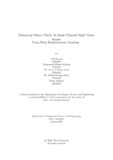| dc.contributor.advisor | Chakrabart, Amitabha | |
| dc.contributor.author | Hossain, Adil | |
| dc.contributor.author | Robbani, Mohammad Elham | |
| dc.contributor.author | Sazid, Md. Riaz Ul Haque | |
| dc.contributor.author | Siam, Sk. Shahiduzzaman | |
| dc.contributor.author | Abtahee, Wasiu | |
| dc.date.accessioned | 2021-10-18T05:38:03Z | |
| dc.date.available | 2021-10-18T05:38:03Z | |
| dc.date.copyright | 2021 | |
| dc.date.issued | 2021-01 | |
| dc.identifier.other | ID 16201065 | |
| dc.identifier.other | ID 17101132 | |
| dc.identifier.other | ID 17101292 | |
| dc.identifier.other | ID 17101289 | |
| dc.identifier.other | ID 20101623 | |
| dc.identifier.uri | http://hdl.handle.net/10361/15329 | |
| dc.description | This thesis is submitted in partial fulfillment of the requirements for the degree of Bachelor of Science in Computer Science and Engineering, 2020. | en_US |
| dc.description | Cataloged from PDF version of thesis. | |
| dc.description | Includes bibliographical references (pages 45-47). | |
| dc.description.abstract | There are a lot of novel approaches to image processing using Machine learning and classical image processing. But most of them take a huge dataset[like machine learning] or they are slow and inefficient[like plain image processing]. Keeping this in context it was always a center of attraction to solve the problem of denoising and clarity enhancing in night vision images. As night vision images are like an asset sometimes, most of the CCTV footage is considered in this. Because if we think simply a complete footage of a CCTV has 50 percent of the recording in day time and 50 percent in night time. And just like that there is 50 percent chance of capturing any event at night. Now if we consider a crime scene which has to be extracted from the cctv footage at night time there is a huge probability of the footage to contain noise , distortion and clarity compromisation. In these scenarios identity extraction is difficult. But along the progress of computation we have image processing and machine learning to develop and filter these images but we talked about the disadvantages before. To train a big dataset for extracting 1 footage is not feasible. So, we are considering a new novel approach which is also considered as state-of-the-art approach of using AI to filter a noisy night time single channel image and enhancing clarity and retain identity in it. In this work we will be facing limited resources and gradually developing those images by training an intelligent agent based on reward bias.So that after training the agent a limited resource it can predict future pixels based on it’s reward bias. Our approach on processing the images will consider deep Q learning and using a convolutional network based on Q learning. Our Aim will be to retain most of the information dealing with these limited resources using a reinforcement learning based approach built with the above stated structure. | en_US |
| dc.description.statementofresponsibility | Adil Hossain | |
| dc.description.statementofresponsibility | Mohammad Elham Robbani | |
| dc.description.statementofresponsibility | Md. Riaz Ul Haque Sazid | |
| dc.description.statementofresponsibility | Sk. Shahiduzzaman Siam | |
| dc.description.statementofresponsibility | Wasiu Abtahee | |
| dc.format.extent | 47 pages | |
| dc.language.iso | en | en_US |
| dc.publisher | Brac University | en_US |
| dc.rights | Brac University theses are protected by copyright. They may be viewed from this source for any purpose, but reproduction or distribution in any format is prohibited without written permission. | |
| dc.subject | limited dataset | en_US |
| dc.subject | Deep Q learning | en_US |
| dc.subject | Intelligent agent | en_US |
| dc.subject | Reinforcement learning | en_US |
| dc.subject | Deep Q network | en_US |
| dc.subject | Single channel images | en_US |
| dc.subject | Night cctv footage | en_US |
| dc.subject.lcsh | Intelligent agent | |
| dc.title | Enhancing object clarity in single channel night vision images using deep reinforcement learning | en_US |
| dc.type | Thesis | en_US |
| dc.contributor.department | Department of Computer Science and Engineering, Brac University | |
| dc.description.degree | B. Computer Science | |

